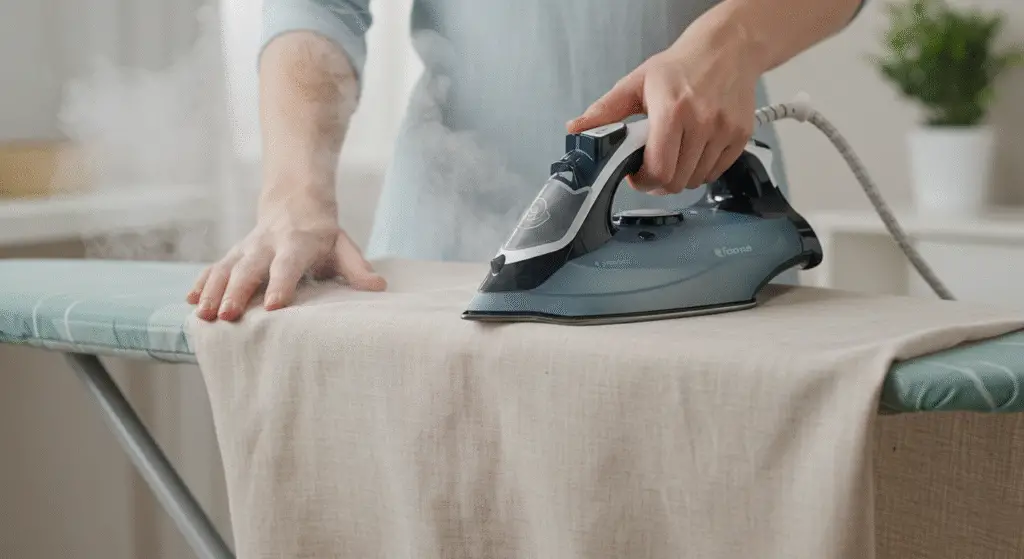
Can You Iron Linen Without Damaging It? Linen is one of those fabrics that instantly brings to mind effortless style, comfort, and a natural, breathable feel. Whether it’s summer clothing, bedsheets, or tablecloths, linen is always in fashion for its lightweight, airy qualities. But when it comes to caring for linen, many people wonder—can you iron linen without ruining its look and texture?
The answer is yes, you can. Ironing linen isn’t as tricky as it may seem, but there are a few things to keep in mind if you want the best results without causing any damage to this delicate yet durable material. In this post, we’ll explore how to properly iron linen, when it’s best to do it, and some expert tips to make the process easier and more effective.
Why Linen Wrinkles So Easily
Linen is made from flax fibers, which are strong but have little elasticity. This means that linen doesn’t bounce back into shape easily after being folded, sat on, or washed. The natural fibers tend to crease and wrinkle more noticeably than synthetic fabrics or cotton.
That’s one reason people ask: can you iron linen and still keep its soft, natural appearance? It’s a fair question, especially since improper ironing can lead to shiny marks, fabric damage, or even scorching. Luckily, with the right tools and a little know-how, you can make wrinkled linen look smooth and polished without losing its natural charm.
When to Iron Linen for the Best Results
One of the best times to iron linen is when it’s slightly damp. In fact, this is often the key to successful linen ironing. If you’ve just washed your linen items, don’t wait until they are completely dry. Slightly moist linen responds better to heat and is easier to smooth out.
If your item has already dried, you can still iron it effectively by misting it lightly with water before you start. You can also use the spray function on your iron if it has one. Moisture helps relax the fibers, making them easier to press flat.
Choosing the Right Iron Settings
When you’re getting ready to iron linen, the heat setting is important. Most modern irons come with a fabric guide, and linen typically requires one of the highest temperature settings. However, it’s not just about heat—steam plays a big role, too.
Using the steam function on your iron is essential for getting good results with linen. Steam softens the fabric as you iron, making it easier to remove wrinkles while protecting the material from heat damage. If your iron doesn’t produce enough steam, using a spray bottle of water is a helpful alternative.
Always read the care label on your linen item. Some linen blends or special finishes might call for lower temperatures, or even recommend using a pressing cloth to avoid direct heat contact.
Ironing Tips for Clothes, Tablecloths, and More
Whether you’re ironing a linen shirt, a dress, or a set of curtains, the technique is generally the same. Start with a clean, flat ironing surface and make sure your iron is clean to avoid stains or marks.
For clothing, turning the item inside-out can help protect the fabric from developing unwanted shine. Move the iron gently over the linen in long, even strokes. There’s no need to apply extra pressure; let the heat and steam do the work.
Larger linen items like tablecloths, duvet covers, or drapes may need to be ironed in sections. Fold them carefully as you go to prevent wrinkling the parts you’ve already ironed. It helps to have a large ironing board or even a clean flat surface if your board isn’t big enough.

Using a Pressing Cloth
If you’re dealing with delicate or dark-colored linen, using a pressing cloth can be a smart move. This is simply a thin piece of fabric—usually cotton or muslin—that you place between the iron and your linen item.
The pressing cloth acts as a barrier, protecting the linen from direct heat while still allowing the steam to penetrate. This can help you avoid those shiny spots that sometimes appear when the iron is too hot or left in one place too long.
Alternatives to Ironing
Maybe you’re wondering if there are other ways to remove wrinkles besides ironing. If you’re in a hurry or dealing with items that are awkward to iron, like ruffled dresses or fitted sheets, a handheld steamer can be a great option.
Steamers don’t make contact with the fabric, which means there’s less risk of scorching or marking the linen. They’re also faster for touch-ups. Simply hang the garment and move the steamer slowly up and down the fabric to release the wrinkles.
Another option is to embrace the natural look of linen. Slight wrinkling is part of linen’s relaxed charm, and many people choose to wear or use linen in its natural state without ironing at all.
Keeping Linen Wrinkle-Free Longer
Once you’ve gone through the effort of ironing, the last thing you want is to have wrinkles return right away. Here are a few simple tips to help maintain the smooth look of your linen items:
- Hang clothing items immediately after ironing to let them cool and set into shape.
- For folded linens like tablecloths or napkins, fold them gently and store them in a flat, dry space.
- When packing linen for travel, try rolling instead of folding to prevent creases.
- Avoid overcrowding in your wardrobe or drawers. Give linen room to breathe.
Final Thoughts
So, can you iron linen without damaging it? Absolutely. With the right heat, a bit of steam, and gentle handling, linen can be ironed to look crisp and fresh without losing its character. The key is to treat it with care—iron it slightly damp, use the correct settings, and consider using tools like pressing cloths or steamers when needed.
Whether you’re pressing a shirt for work, smoothing a tablecloth for dinner, or simply refreshing a dress before an event, linen responds beautifully to thoughtful ironing. And once you’ve done it a few times, it becomes a simple and satisfying part of maintaining your favorite pieces.
